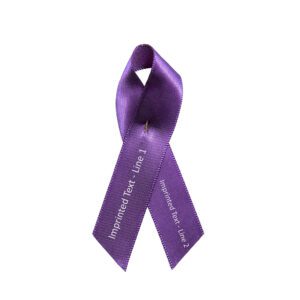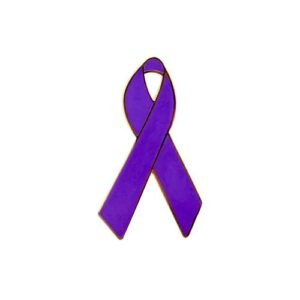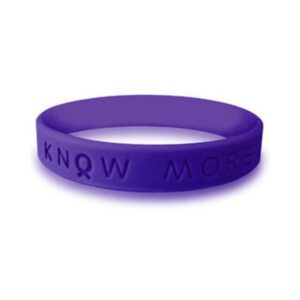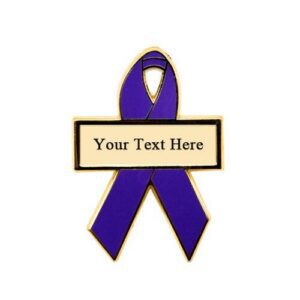Search by Color or Cause
$49.95
Wear your heart on your sleeve with a purple fabric awareness ribbon on your lapel.
Shop Personalized Cause for awareness ribbons, pins, and wristbands for over 1000 causes.
Our purple cloth fabric ribbons come in bags of 250 pieces (bulk).
Simple awareness ribbons started it all: a global movement for a better tomorrow. Today, an awareness ribbon is an iconic, worldwide symbol of hope for warriors and survivors, alike. For over twenty years, Personalized Cause has been at the forefront of the awareness ribbon movement, and strives to keep abreast of ever-changing awareness color and cause updates. Through this attention to cause awareness, Personalized Cause raises hope, encourages compassion, and highlights medical, social, mental health, autoimmune, and cancer causes. These causes are near and dear to many. Pin a ribbon to your lapel to show support for cancer research fundraisers or group marches for social change,
Personalized Cause has the most up-to-date and comprehensive awareness cause and color reference guide on the internet. Because of that, it has taken years to compile a list that is accurate and inclusive. You can find this extensive cause list under Awareness Ribbons Colors Causes and Meanings | Reference Guide. You can also use the Find Your Product search tool on the Home Page to find the product you’re looking for – search by color or cause.
Grosgrain ribbons primarily contain cotton, polyester and fiber blends. Satin ribbons, on the other hand, primarily contain nylon or polyester. Grosgrain ribbons also have thick horizontal fibers, whereas satin ribbons are smooth to the touch. Satin ribbons are much softer than grosgrain ribbons. Many people love satin ribbons for their beautiful shiny finish, allowing them to create a sleek look.
Double-faced satin ribbon is perhaps the most common type of satin ribbon available. Like the name suggests, this ribbon has two right sides. Therefore, it doesn’t matter what side faces upward or outward, as both of the sides look the same. The alternative is a single faced ribbon, which has a shiny outer side and a muted underside. Our satin ribbons are double-faced.
We offer these purple fabric awareness ribbons in bags of 250 pieces. Our ribbons are perfect for fundraising, awareness events, cancer races, awareness campaigns, support groups, school fundraisers, funerals, memorial gifts, and promotional products. Wearing awareness ribbons sends a subtle message that you support a cause. For example, it might mean you are raising awareness for a particular social cause. Another reason to wear a ribbon is to support a medical or mental health cause. Further, perhaps the ribbon represents a cause that personally connects to a cause affecting animals. Again, the ribbon sits on the left side of the chest or over the heart which is symbolic for a cause that is heartfelt.
Please note: We cannot personalize these ribbons. However, click here to see our personalized fabric ribbons in similar colors with an attached safety pin on the back of the fabric ribbon.
Purple Awareness Ribbons – Causes, Colors, Meanings and Months:
The primary causes associated with purple awareness ribbons is Alzheimer’s Disease and Dementia, Autoimmune Disorders, Chronic Pain, Drug Overdose Awareness, Epilepsy and Seizure Disorders, Headaches, and Stomach-Related Illnesses. Of course, there are many others.
Alzheimer’s Disease and Dementia
Dementia is an umbrella term that describes a collection of symptoms (cognitive, functional and behavioral) that are caused by specific diseases. Alzheimer’s disease is the most common disease that causes dementia, but Frontotemporal degeneration, Lewy Body disease, and vascular disease can all cause symptoms of dementia. Not all cognitive decline is considered dementia. Dementia must be driven by an underlying progressive neurodegenerative disease.
Alzheimer’s Disease and Dementia causes may include:
Alzheimer’s Disease
Dementia
Lewy-Body Dementia
Autoimmune Disorders
Autoimmune disorders are a group of diseases that occur when the body’s immune system mistakenly attacks healthy cells, tissues, and organs. There are more than 80 known autoimmune diseases.
Autoimmune Disorders causes may include:
Autoimmune Diseases
Fibromyalgia
Lupus / SLE
Sjogren’s Disease
Sjogren’s Syndrome
Chronic Pain
Chronic pain lasts months or years and can affect any part of the body. It interferes with daily life and can lead to depression and anxiety. The first step in chronic pain management is to find and treat the cause. When that isn’t possible, a combination of medications, therapies and lifestyle changes may be suggested.
Drug Overdose Awareness
August 31 is recognized as International Overdose Awareness Day the world’s largest annual campaign to end overdose, remember those we have lost to an overdose, acknowledge the grief of the family and friends left behind, and renew our commitment to end overdose and related harms.
Drug Overdose causes may include:
Drug Overdose
Fentanyl Overdose
International Overdose Awareness Day
Opioid Addiction
Epilepsy and Seizure Disorders
Epilepsy is characterized by having two or more unprovoked seizures that occur more than 24 hours apart. A seizure is a brief episode of involuntary movement in the brain that can range from a slight lapse of attention to a severe convulsion. A seizure disorder is a brain condition that causes seizures, which are abnormal electrical surges in the brain. The most common type of seizure disorder is epilepsy.
Epilepsy and Seizure Disorder causes may include:
Epilepsy
Infantile Spasms
Seizure Disorders
Headaches
A headache is pain or discomfort in the head or face. Headaches can be caused by many things, including stress, muscle tension, infections, and hormonal changes. They can range from mild to severe, and can last from 30 minutes to several days.
Headache causes may include:
Chronic Headaches
Cluster Headaches
Migraine Headaches
Stomach-Related Illnesses
Stomach diseases can be caused by a number of things, including infections, inflammation, illness, or underlying conditions. Some common causes include stress, bile reflux, excess alcohol, chronic vomiting, and use of certain medications.
Stomach-Related Illness causes may include:
Colitis
Crohn’s Disease
Inflammatory Bowel Disease / IBD
Gastrointestinal Stromal Tumors
Microscopic Colitis
Pancreatic Cancer
Pancreatitis
Ulcerative Colitis
Purple Ribbon Causes Include:
Arnold Chiari Malformation
Cancer Survivors (alternate color: Lavender)
Cornelia de Lange Syndrome / CdLS
Cystic Fibrosis
Domestic Violence
Drowning Impact
Elder Abuse
Gynecologic Cancer (alternate color: Teal and Purple)
Homeless Youth
Homelessness
Idiopathic Thrombocytopenic Purpura / ITP
International Women’s Day
Macular Degeneration
Mast Cell Diseases
Military Personnel Injured in Active Duty
No Unattended Kids in Cars
Neuropathy
Pediatric Hemiplegia
Peripheral Neuropathy
Prematurity
Pulmonary Arterial Hypertension
Pulmonary Hypertension
Relay for Life / American Cancer Society
Rett Syndrome
Sarcoidosis
Victims of Homophobia (alternate color: Rainbow)
Vitiligo
Awareness Months for Purple Causes
Alpha-1 Antitrypsin Deficiency Awareness Month – November
Alzheimer’s Disease Awareness Month – June
Animal Abuse Awareness Month – April
Arnold Chiari Malformation Awareness Month – September
Autoimmune Diseases Awareness Month – March
Cancer Survivors Awareness Month – June
Cerebrospinal Fluid Leak Awareness Week – First Week of June
Chronic Migraine Awareness Day – June 29
Chronic Pain Awareness Month – September
Chronic Recurrent Multifocal Osteomyelitis Awareness Month – October
Cluster Headaches Awareness Day – March 21
Colitis Awareness Month – November
Cornelia de Lange Syndrome / CdLS Awareness Month – May
Craniosynostosis Awareness Month – September
Crohn’s Disease Awareness Month – December
Cystic Fibrosis Awareness Month – May
Dementia Awareness Month – June
Domestic Violence Awareness Month – October
Dravet Syndrome Awareness Month – June
Drowning Impact Awareness Month – May
Drug Overdose Awareness Day – August 31
Elder Abuse Awareness Month – June
Epilepsy Awareness Month – November
Fentanyl Overdose Awareness Day – August 21
Fibromyalgia Awareness Month – May
Gastrointestinal Stromal Tumors Awareness Day – July 31
Gynecologic Cancer Awareness Month – September
Headaches Awareness Month – June
Homeless Youth Awareness Month – November
Homelessness Awareness Month – November
Hurler Syndrome Awareness May – May 15
Idiopathic Thrombocytopenic Purpura / ITP Awareness Month – September
Infantile Spasms Awareness Week – December 1-7
Inflammatory Bowel Disease / IBD Awareness Month – November
International Overdose Awareness Day Awareness Day – August 31
International Women’s Day Awareness Day – March 8
Keratoconus Awareness Day – November 10
Leiomyosarcoma Awareness Month – July
Lewy-Body Dementia Awareness Month – October
Lupus / SLE Awareness Month – May
Macular Degeneration Awareness Month – February
Mast Cell Diseases Awareness Day – October 20
Microscopic Colitis Awareness Week – April
Migraines Awareness Month – June
Military Family Appreciation Month (MFAM) – November
Mucopolysaccharidoses / MPS Awareness Day – May 15
Multiple System Atrophy Awareness Month – August
National Opioid Awareness Day – September 21
National Recovery Month – September
National Substance Use Prevention Month – October
No Unattended Kids in Cars Awareness Month – April
Neuropathy Awareness Month – May
Opioid Addiction Awareness Month – September
Overdose Awareness Day – August 31
Pancreatic Cancer Awareness Month – November
Pancreatitis Awareness Month – November
Pediatric Hemiplegia Awareness Month – May
Peripheral Neuropathy Awareness Month – May
Prematurity Awareness Month – November
Pulmonary Arterial Hypertension Awareness Month – November
Relay for Life / American Cancer Society Awareness Month –
Rett Syndrome Awareness Month – October
Sarcoidosis Awareness Month – April
Seizure Disorders Awareness Month – November
Sjogren’s Disease or Sjogren’s Syndrome Awareness Month – April
Ulcerative Colitis Awareness Month – November
Vitiligo Awareness Month – June
WHAT IS THE HISTORY OF THE AWARENESS RIBBON?
In 1979, Penney Laingen’s husband was held prisoner during the Iran hostage crisis. To call attention to this, she placed yellow ribbons on trees in her neighborhood. She also created yellow ribbons for people to wear to show support for her husband and others being held hostage. This was the first time an awareness ribbon was used publicly as a way to silently voice support.
About ten years later, the group Visual AIDS used a bright red ribbon to represent awareness and support for AIDS and the lives lost to it. This trend caught on quickly. Awareness ribbons were so well accepted as a way to demonstrate support, in fact, that the New York Times declared 1992 as The Year of the Ribbon.
That was the same year the pink ribbon became associated with breast cancer. The Susan G. Komen Breast Cancer Foundation (now Susan G. Komen for the Cure) handed out pink hats to breast cancer survivors who participated in their Race for the Cure. Soon after, in 1992, Komen distributed pink ribbons to everyone who participated in the race.
The next big step came later that year. Alexandra Penney, editor of Self Magazine, produced their second annual Breast Cancer Awareness Month issue. This issue was inspired by Evelyn Lauder, Vice President of Estee Lauder. She was also a breast cancer survivor. Alexandra and Evelyn collaborated to create a pink ribbon to distribute in cosmetic stores throughout New York City. This action was so popular that eventually the pink ribbons were placed on cosmetics counters all across the United States during Breast Cancer Awareness Month.
That year, 1.5 million ribbons were distributed. On each one was a card that explained how to do self breast exams. They also collected over 200,000 petitions, asking the White House to provide additional funding for breast cancer research.
The next year, in 1993, popularity grew. Avon joined in the fight for breast cancer awareness and launched a pink rhinestone brooch in the shape of the pink awareness ribbon. In two years, sales from the pin raised over $10 million for breast cancer research. This visibility helped make everyone more aware of the need for research.
Many people believe that because of these awareness ribbons and the visibility they created, federal funding for breast cancer research increased from approximately $100 million in 1991 to over $550 million in 1996. This helped pave the way for pink ribbons and other colors, calling attention to the need for research money for causes such as autism, epilepsy, Alzheimer’s and many more.
Calling attention to various diseases and disorders, as well as social causes, is the impetuous behind awareness ribbons. Showing support and understanding can often make all the difference to those who struggle.




